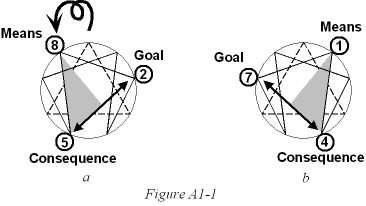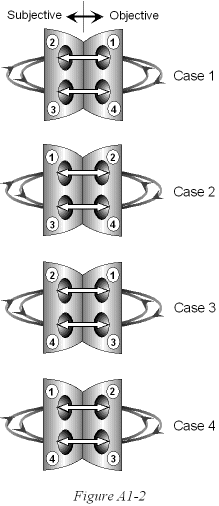Back • Return Home
Human Values and Involution
Robert Campbell, 2010
Taken in part from Appendix 1 of Fisherman's Guide.
Further Discussion of System 4
There are many other aspects to System 4 that could be elaborated upon, and a couple of further points deserve special mention. The manner in which the mediating universal triangle inverts at the middle of each cycle, then reverts back at the end of each cycle, does more than regulate the transitions back and forth between the expressive and regenerative modes. It also induces alternating inverse activities in the operation of the six pointed figure, as shown in Figure A1-1.
Figure 1a shows the inverted alignment of the mediating triangle. This induces a complementary inverse activity, as shown in Figure 1b.
There are two curious things about these inverse activities. The tensional pairs illustrated by the arrows are coupled. The creative Idea in Term 2 is linked to Production in Term 5 as shown in Figure 1a. This insures that the production operation is continuously relevant to the idea inherent in the product idea.
In Figure 1b, Memory recall in Term 7 is linked to Organized sensory input in Term 4. This ensures that memory recall is always relevant to sensory input. We recall relevant actions, thoughts, feelings, and information according to current circumstance. Otherwise, we could not function coherently and appropriately according to how changing situations are presented to us.
The tensionally coupled pairs are perceived from the perspective of Marketing and Sales, respectively. In the context of personal organization, Marketing is the perception of situational needs, while Sales balances the perception of sensory needs with a planned motor response.
Involution versus Evolution
To this point, all discussions have referred to the evolutionary form of the creative matrix, through which all experience is integrated. There is also an involutionary form that leads to fragmentation and decay. It is outlined by switching the relative positions of Centers 3 and 4 in the terms of the matrix, and it has an expressive and regenerative mode as well.
There is not space to go into the involutionary form in detail except to show how it can come into play through an inverted perspective in Term 1. This has been called the Perception of the Field Term, and also the Marketing Term. It concerns how we perceive the needs of a situation.
When Centers C3 and C4 exchange places, values become inverted. Ideas (C1) become translated into Routines (C3) rather than into Forms (C4) with meaningful value. Routines become ends in themselves. Vested interests prevail over constructive responses. Things are done for their own sake, whether they make sense or not. Examples about around us, from the profit motive in business that exploits both customer and employee for short term executive bonuses and stock market sellouts, to the kind of nationalism that becomes an aggressive end in itself rather than a channel through which to contribute to a better world. The experience of unity is sought in pursuing self interest to the exclusion of others.
Remembering distinct from Action
In addition, there are two more forms to System 4 that are relevant to conscious thought, feeling, and behavior. They concern remembering, as distinct from recall that is directly committed to automated activity, such as walking. Remembering in itself does not require overt activity. It can be restricted to a conscious process, such as remembering the car accident you had last week. Since there is both an evolutionary and an involutionary remembering process, altogether there are a total of four possible forms to System 4, each with expressive and regenerative modes.
The terms of the evolutionary remembering matrix involve switching the positions of Centers 1 and 2 with Centers 4 and 3, respectively. In the evolutionary remembering matrix, Centers 1 and 2 exchange places.
The perceptual-referent term, Term 1, plays a special role in determining which of the four forms of System 4 comes into play. How we perceive the context affects the outcome of the creative process. There are only four possible alignments for the coalesced pairs of centers in Term 1. They are shown in Figure A1-2.
Cases 1 and 2 are the expressive and regenerative modes of evolutionary activity. Cases 3 and 4 are the expressive and regenerative modes of involutionary activity. Cases 1 and 3 are expressive and regenerative modes of evolutionary remembering. Cases 2 and 4 are the expressive and regenerative modes of involutionary remembering.
It is thus apparent that activity and remembering share a common perceptual referent in Case 1, as the evolutionary form of expression, and in Case 4 as the involutionary form of regeneration.
In Cases 2 and 3, the perceptual referents are at cross-purposes.
Case 2 is the regenerative mode of evolutionary activity and the expressive mode of involutionary remembering. This means that the same perceptual referent can both sustain a remembering of past mistakes, and also guide the active formation of a creative idea.
Case 3 is the expressive mode of involutionary activity and the regenerative mode of evolutionary remembering. This means that the same perceptual referent can be used either to guide the regeneration of resources needed to perpetuate mistakes, or to guide a creative remembering of what should be done instead.
The remembering forms of the creative activity permit a cross linking of evolutionary and involutionary activity. They are otherwise mutually exclusive. This means there is a tug-of-war involved. It is a moral struggle, through which involuted energies that lead to fragmentation and decay can be redeemed. We experience this bi-polar moral disparity in how we make value judgments every time we make meaningful decisions that require us to weigh options. This is universally implicit in the nature of human perceptions.
The Sales-Marketing polarity (T8 ↔ T1) employs our emotional limbic brain. (See the article Inside Our Three Brains.) Since our emotional apparatus is anchored to our evolutionary history in the biosphere, the intentional quality of our efforts impacts our natural environment, in addition to affecting the quality of our own emotional experience and that of others around us.
Other Variants of System 4
There are two other variants to System 4 that are structurally possible, but they have no conscious meaning. Centers 1 and 3 can coalesce along with Centers 2 and 4. This means that Idea is coalesced with Routine while Knowledge is coalesced with Form. This may be associated with dream and hypnotic states depending on circumstance.
Alternatively, Centers 1 and 4 can coalesce along Centers 2 and 3. This means that Idea (C1) is coalesced with Form (C4) while Knowledge (C2) is coalesced with Routine (C3). Since the Form of the body itself is dormant, the coalescence with Idea may be associated with sleep or coma states, depending on context. This variant may interact with the dream/hypnotic variant.
Research is needed to determine precisely how these variants can work. It may be possible for them to interact with remembering variants as in day dreaming fantasies, or with action variants as in sleepwalking.
The Evolutionary and Involutionary Variants of System 3
System 3 is the first of the Systems to have an involutionary variant. It is simpler than those of System 4.
In physics, this variant exhibits as antimatter. The universal set tunnels through the three centers of each particular set, intimately linking them up in reverse order. In an atom, the electronic charges of electron and proton are thus reversed, since charge is determined by how the universal set links up Centers 2 and 3 of each particular set. (See System 3.) When this is reversed, charge is reversed. System 3 also relates to pair creation where an electron and positron are created from a sufficiently energetic photon. Antiprotons can be created by very high energy collisions in particle accelerators. Although they are considered stable, antiparticles are degenerate variants of System 3 that annihilate in contact with ordinary matter. This occurs in collisions of cosmic rays with atomic nuclei in nature.
In biological organization, System 3 shows how the universal set intimately links up Host Organ and Cell of each particular set. This requires that there is a universal energy pattern associated with Host, Organs, and Cells for each distinct species. The universal set tunnels through each particular set or individual Host of a species, intimately linking up its Organs and its Cells. The genetic characteristics of each individual human, for example, are within each Cell, which constitutes the collective organs of the whole body. For the individual to evolve normally, the universal and particular organ and cell interfaces (or Centers 2 and 3) must mutually coincide. If this relationship is reversed so that the universal organ interface (UC2) is aligned with the particular cell interface (PC3), while UC3 is aligned with PC2, then the process is degenerate, just as antimatter is. This can happen in part or all of the body, resulting in terminal diseases. Cells can proliferate as cancerous organs (tumors), destroying the organs that host them. This involutionary variant of System 3 can result from involutionary variants of System 4 related to less serious health conditions but that get out of hand.
System 2
It is significant that System 2 has only two possible structural orientations. One of them is objective or expressive and the other is subjective or regenerative. System 2 has no involutionary variant. This is especially meaningful since System 2 transcends and subsumes the Void, and with it, the whole of creation. It is in this way that the energies of involutionary variants may be purged from the evolutionary process if they threaten the evolutionary variants they feed on. They can be reinvested in more refined ways as with the diversification of the mammals following the demise of the dinosaurs.
We are all familiar with meaningful intervention in the creative process when the need arises. If our appetite runs away with us, making us obese, we may have to diet and consciously maintain more balanced eating habits to sustain our health. We have to relate in a subjective orientation to the subjective state of our body. Similarly, if corrupt practices in our social and business organizations become rampant, there must be an investigation of the participants within the organization that should be purged and replaced. And if we humans continue to overrun and strip the planet's resources, there will be a painful natural correction. We all know there are limits to what we can do with impunity and we have to self correct or suffer consequences. This happens in analogous ways at all levels of phenomenal experience.


